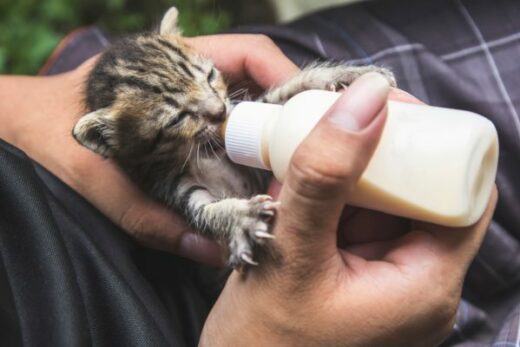Outdoor cats can easily adapt to many types of weather. But on bitterly cold winter days, outdoor cats can use assistance from their human friends. A dry shelter box and extra food can help your kitty to get through the toughest part of winter. In this post, we’ll cover everything you need to know about how to protect outdoor cats in winter.
Table of contents
- Can cats survive winter outdoors?
- What temperature can cats still survive outside?
- Bring your cat inside
- Provide warm, dry shelters
- Building or buying a cat shelter: what is best for outdoor cats?
- Why size matters with cat shelters
- What to put in your outdoor cat shelter
- Insulate the shelter against moisture as well as cold
- Provide plenty of warmed food and water
- How much food should I give a cat in the winter?
- Where to place food and water
- How to keep outdoor cats’ food and water from freezing
- Track your cat’s winter adventures with a GPS cat tracker
- Stray cats, feral cats, and outdoor cats: what’s the difference?
- Stray cat winter safety tips
- How to get feral and stray cats to use your shelter and feeding station
- Make cat care part of your winter routine
Can cats survive winter outdoors?
Cats that spend the entire year going outdoors will grow a thick coat of fur as cold weather approaches. Your outdoor cat probably has strategies for staying warm and dry when outside in the winter – a secret nook to stay out of the weather, a neighbor that leaves pet food outdoors, or a lucky spot for hunting rodents.
Surviving the winter outdoors is one thing – staying healthy and strong is another. You can help your outdoor cat survive the winter in better condition by providing a cat shelter, lots of food, and unfrozen water in very cold weather.
What temperature can cats still survive outside?
Experts agree that outdoor temperatures under 32 degrees Fahrenheit (0 degrees Celsius) can pose a danger to cats if they do not have access to a suitable shelter. When temperatures drop below freezing, cats can be at risk for hypothermia and frostbite, both of which are life-threatening conditions.
An indoor cat that goes outdoors only occasionally will not be able to handle below-freezing temperatures for more than a few minutes. For cats that are primarily indoor cats, keep them inside when the thermometer falls below 45 degrees Fahrenheit (7 degrees Celsius) just to be on the safe side.

Bring your cat inside
The best way to protect your cat from cold temperatures is to bring them inside where they can stay warm and cozy with access to plenty of food, water, and snuggles. For indoor cats, this should be no problem.
If you have an indoor/outdoor cat, try to bring them indoors at night when temperatures are the coldest. Be sure they have access to a shed, barn, or cat shelter to get out of the weather during the day.
If you care for a true outdoor cat or you support stray or feral cats, providing shelter is very important, as well as offering unfrozen water and dry food. Note that many of the creatures that outdoor cats hunt, such as mice and small animals, are hunkered down in the winter, so the cats’ natural food supply is limited in very cold weather.
Provide warm, dry shelters
If bringing your cat indoors is not an option, you can create a simple shelter box to keep kitty warm, safe, and dry all winter. Shelters are also a way to offer a warm retreat for stray or feral cats in your neighborhood during cold weather.
Building or buying a cat shelter: what is best for outdoor cats?
You can build a permanent shelter out of wood, similar to a small doghouse, using plans that are available online. Or, you can buy a ready-made or easy-to-assemble cat shelter from a number of online retailers.
An outdoor cat seeking a warm hideout is not going to be fussy about the type of shelter you provide in winter. However, your neighbors might appreciate it if the shelter somewhat attractive, well camouflaged, or hidden in a wooded or brushy area.
A less expensive DIY cat shelter can be built from a plastic storage tote. Use a box cutter to cut out front and rear openings that are about six to eight inches square – just big enough to let a cat squeeze in, but small enough to keep the cold air out. A rubber flap on the doors will further protect kitty from the cold. Just be sure the flap does not prevent the cat from easily entering and leaving the shelter box.
Why do you need a second door opening on the rear of the shelter box? If an unwanted intruder, such as a wild animal, enters the shelter, the cat will have an escape hatch to make a quick exit.
Use duct tape or caulk to firmly attach the lid to the tote. Set the shelter box on a pallet, a few boards, or bricks to elevate it off the cold, damp ground. Raising the box a few inches will help to insulate it and keep rain or snow from seeping in through the doorway from the ground.





